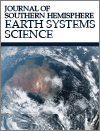
Journal of Southern Hemisphere Earth Systems Science
Volume 71 Number 1 2021
ES19050Tracking and short-term forecasting of mesoscale convective cloud clusters over southeast Brazil using satellite infrared imagery
This paper presents the tracking and short-term forecasting of mesoscale convective cloud clusters (CCs) that occurred over southeast Brazil during 2009–17. The CC tracking showed a high frequency of CCs over the Atlantic Ocean and mainly over continental and coastal southeast Brazil. The short-term forecasting revealed relatively good forecasts for 30–60 min. For longer times, forecasts overestimated the occurrences, intensities and growth of the CCs. These results are very important for Brazilian weather forecast centres, civil defense institutions and industry.
ES19050 Abstract | ES19050 Full Text | ES19050PDF (2.3 MB) Open Access Article
ES19051Cutoff low over the southeastern Pacific Ocean: a case study
A cutoff low (COL) was identified over the southeastern Pacific Ocean at 30°S 90°W, which moved towards the northeast (close to Peru), favouring unusual rainfall on the central coast (Chosica 9.0°S, 77.8°W) with 37 mm over the span of 6 h (5 April 2012) compared to the monthly average of 0.9 mm. During the event, the humidity advection came from the Amazon basin and the northern coast. At the same time, trade winds from the southeast changed direction towards the northwest, influenced by the presence of the COL, favouring humidity and heat advection, which favoured convection. This event resulted in the loss of human lives, several injured people and infrastructure damage.
ES19051 Abstract | ES19051 Full Text | ES19051PDF (9 MB) Open Access Article
ES19052Severe convection-related winds in Australia and their associated environments
Damaging winds related to severe thunderstorms are a dangerous hazard for people and infrastructure. Observations of these damaging wind events are relatively limited, which is not ideal for examining their average chance of occurrence for risk assessment applications. Here we analyse atmospheric environments related to thunderstorms that produce severe wind gusts, based on gridded data throughout Australia over many years. This is intended to help enable improved preparedness for severe winds and the damages they can cause.
ES19052 Abstract | ES19052 Full Text | ES19052PDF (923 KB) Open Access Article
ES19053Interdecadal modulation of the effect of ENSO on rainfall in the southwestern Pacific
The Interdecadal Pacific Oscillation modulates the strong relationship between rainfall and the El Niño Southern Oscillation (ENSO, measured by the Southern Oscillation Index) in Australia. This paper analyses 100 years of observed rainfall to examine how this relation extends across the Pacific Islands. We find little modulation in Vanuatu, Fiji and (especially) Cook Islands, places where movement of the South Pacific Convergent Zone (driven by ENSO) has a direct influence on rainfall, which is not the case in Australia.
ES19053 Abstract | ES19053 Full Text | ES19053PDF (1.5 MB) Open Access Article
ES20010The Antarctic ozone hole during 2018 and 2019
 , Matthew B. Tully, Paul B. Krummel, Stuart I. Henderson, Dan Smale
, Matthew B. Tully, Paul B. Krummel, Stuart I. Henderson, Dan Smale  , Richard Querel, Sylvia Nichol, Simon P. Alexander, Paul J. Fraser and Gerald Nedoluha
, Richard Querel, Sylvia Nichol, Simon P. Alexander, Paul J. Fraser and Gerald Nedoluha
The behaviour of the annual Antarctic ozone hole provides insights for monitoring the effectiveness of the Montreal Protocol and for understanding interactions between ozone depletion and climate. Here, the factors underlying the relatively large Antarctic ozone hole of 2018 and the much smaller hole in 2019 are examined. The difference in the severity of ozone depletion between the two years is ascribed to inter-annual variability in meteorological conditions.
ES20010 Abstract | ES20010 Full Text | ES20010PDF (7.4 MB) Open Access Article
Distinct climatic regions and seasons of southern Australia have been identified based on clustering of the most important weather systems for rainfall. We find that the cool season in southern Australia can be best defined as April–September and the warm season as October–March. The spatial clustering varies by season, while the appropriate seasonal breakdown also varies by region.
ES20003 Abstract | ES20003 Full Text | ES20003PDF (4.1 MB) Open Access Article
East coast lows (ECLs) can cause very heavy rainfall along the east coast of Australia, but not all lows cause the same level of impacts. In this study, we identified some characteristics common to those ECLs that cause the heaviest rain. We found no strong trends in these systems in recent decades, but understanding which ECLs are associated with heavy rainfall may help us better identify how future climate change may influence ECLs and their impacts.
ES20013 Abstract | ES20013 Full Text | ES20013PDF (1.4 MB) Open Access Article
The disastrous 2019 north Queensland floods are examined to determine the reason for their development and their comparison with previous record historical events.
ES20005 Abstract | ES20005 Full Text | ES20005PDF (11.9 MB) Open Access Article
This is a summary of the southern hemisphere weather and climate for summer 2018–19; an account of seasonal rainfall and temperature for the Australian region is also provided. January 2019 was Australia’s hottest month on record, nearly 1°C warmer than any previous month. Extreme heatwaves occurred on land and in oceans in the southern hemisphere. Impacts of heavy rain and floods were reported in Australia, New Zealand and South America. Case studies of the Australian heatwave, Queensland floods and a tide-driven coastal inundation event are considered.
ES20009 Abstract | ES20009 Full Text | ES20009PDF (4.4 MB) Open Access Article


